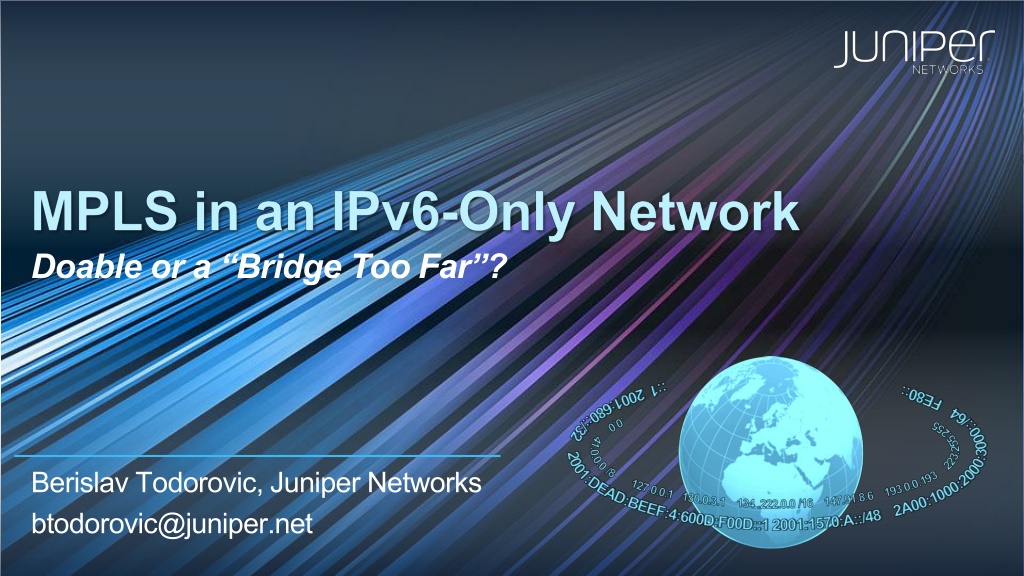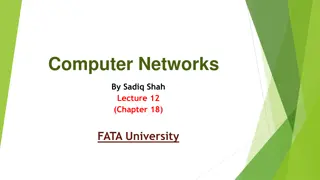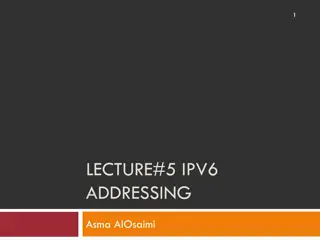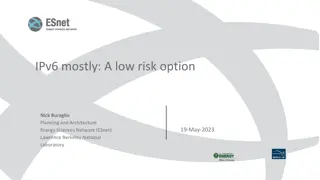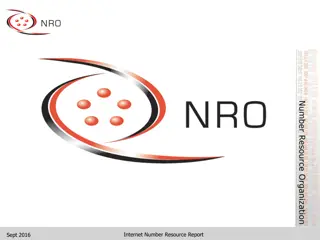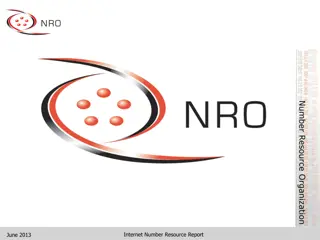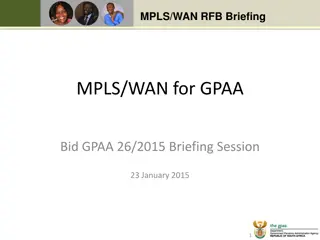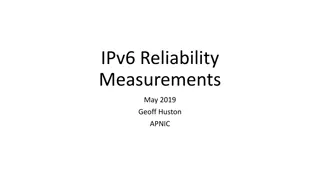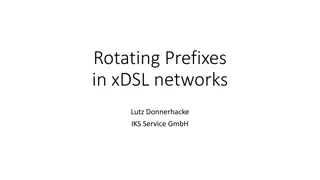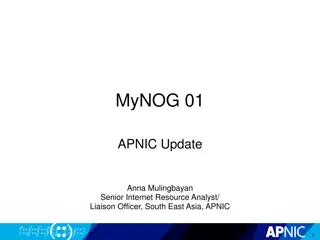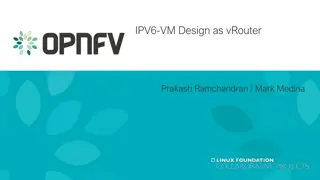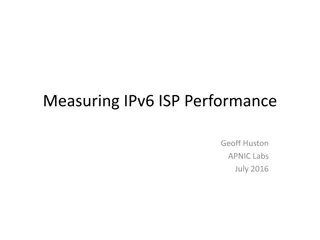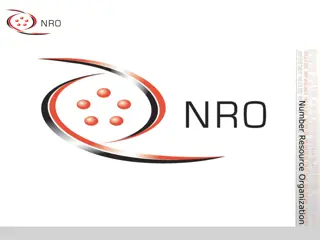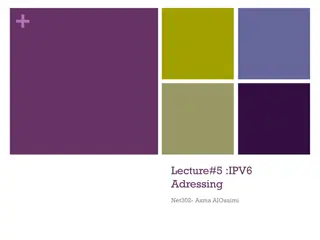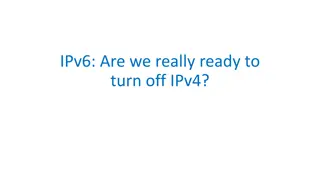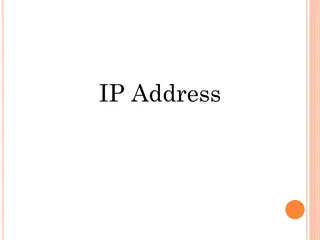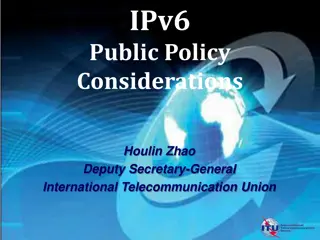Navigating IPv6 and MPLS Challenges for IPv4 Core Edge Transition
Explore the transition solutions and challenges for integrating IPv6 at the edge of an IPv4 core network, including 6PE, 6VPE, MPLS transport options, and the potential for IPv4 elimination. Discover the evolution toward IPv6 adoption in networking standards and the persistent role of MPLS in modern networks despite its IPv4-centric origins.
Download Presentation

Please find below an Image/Link to download the presentation.
The content on the website is provided AS IS for your information and personal use only. It may not be sold, licensed, or shared on other websites without obtaining consent from the author. Download presentation by click this link. If you encounter any issues during the download, it is possible that the publisher has removed the file from their server.
E N D
Presentation Transcript
Doable or a Bridge Too Far? Berislav Todorovic, Juniper Networks btodorovic@juniper.net
Agenda Intro the IPv6 prelude and the MPLS fugue ... IPv6 and MPLS current solutions for the IPv6 edge of an IPv4 core: 6PE, 6VPE, IPv6-over-TE tunnels ... or native IPv6 MPLS over an IPv6-only core MPLS transport challenges: LDPv6, RSVP-TEv6, BGP-LU(v6), SPRINGv6 MPLS service challenges in an IPv6 core: L3 VPN L2 VPN VPLS/VPWS/EVPN MVPN Can we get rid of IPv4 actually ???
Prelude IPv6 Takes up ... because they have no other choice (out of v4 stock ) SPs introduce IPv6 to please the nerds RFC 6540 - IPv6 Support Required for All IP-Capable Nodes (2012!) ripe-554 - Requirements for IPv6 in ICT Equipment (2010-2012) IAB Statement on IPv6 (2016): We recommend that all (future) networking standards assume the use of IPv6, and be written so they do not require IPv4. Will the Internet world (eventually?) default to IPv6?
Fugue - MPLS is Still Out There ... MPLS - invented in the late 1990s Envisaged for an odd use case (ATM/IP interworking). But we use it for other reasons today: MPLS VPN Traffic Engineering Fast traffic restoration (FRR) Can t we do it with: overlays, underlays ... ^.*lays$ ... MPLS doesn t give up that easy, like its A** predecessor: Mobile operators just love it! Reason SDH-grade fast restoration, TE ... Problem it was developed assuming an IPv4 core as its foundation!
Prelude Again IPv4 Packet Forwarding Although, IPv6 is the same thing ... Destination 10.1.1.1 11.2.2.2 14.3.3.3 Intf 11 21 31 Destination 14.3.3.3 11.2.2.2 10.1.1.1 Intf 1 2 3 11 31 IP 10.1.1.1 3 1 21 Destination 10.1.1.1 11.2.2.2 14.3.3.3 Intf 1 2 3 2 IP 10.1.1.1 1 11.2.2.2 14.3.3.3 3 2 IP 10.1.1.1
Prelude Again IPv6 Packet Forwarding Destination 2001:a:b::/48 2a01:c::/32 2b01:80:1::/56 Intf 11 21 31 Destination 2a01:c::/32 2b01:80:1::/56 2001:a:b::/48 Intf 2 1 3 11 31 IP 2001:a:b:8::1 3 1 21 Destination 2001:a:b::/48 2a01:c::/32 2b01:80:1::/56 Intf 1 2 3 2 IP 2001:a:b:8::1 1 11.2.2.2 14.3.3.3 3 2 IP 2001:a:b:8::1
Interlude The Label ... Add a 4 byte tag to each IP packet ... RFC3031 just says IP Packet Can be BOTH v4/v6 ... ... or even an Ethernet frame (L2 packet)! L2 Header L2 Header IP Packet IP Packet Label (20 bits) CoS S TTL L2 Header MPLS Header IP Packet 4 bytes
Fugue MPLS Label Switching Classical IP Forwarding (again IPv4 or IPv6 doesn t matter ... yet ...) 50 20 10.1.1.1 IFin 31 LB-in 20 IFout 11 Destination 10.1.1.1 IFin 1 LB-in 50 IFout 3 LB-out 20 11 31 3 1 Can this be IPv6 too? Of course, but ... 21 2 1 11.2.2.2 14.3.3.3 3 50 2 10.1.1.1 Destination 10.1.1.1 11.2.2.2 14.3.3.3 Intf 1 2 3 Lb-Out 50 52 57
Label Stacking Adding more labels to the packets ... L2 Header L2 Header IP Packet Packet L2 Header L2 Header IP Packet Packet Label (20 bits) CoS S TTL Label (20 bits) CoS S TTL MPLS Header L2 Header Packet 4 bytes L2 Header L2 Header Packet Packet MPLS Header L3 Ln L2 L1 4 bytes 4*n bytes Label Stack
Coda - MPLS L3 VPNs Forwarding Plane Using the label-stacking technique to create VPNs 11 10.1.1.1 51 11 10.1.1.1 VPN B Site2 VPN A Site2 CE A2 VPN A Site 1 12 10.1.1.1 51 CE1 A2 Service Label P P CE A1 CE B2 PE 2 PE 1 VPN B Site 1 Transport Label symbols symbols VPN A Site 3 Service Label PE 3 P CE B1 CE A3 12 10.1.1.1
MPLS L2 VPNs Forwarding Plane Pushing Ethernet frames from A to B ( pseudowires ) Pseudowire Label - Designates a pseudowire - Established by IEVPN Edge routers - Not changed in the core - Signalled by LDP or BGP Transport Label - Used to transport the packet - Established hop-by-hop among all routers - Swapped in the core at each hop - Signalled by LDP or RSVP Stripped on egress (Penultimate POP) TLn DA TL1 TL2 DA SA PWL PWL PWL SA DA DA DA 0x9100 0x8100 SA SA SA 1004 2003 Qc Qc 0x9100 0x9100 0x9100 1004 1004 1004 DATA DATA Qc Qc Qc DATA DATA DATA NNI NNI MPLS CORE
Problem Label Signaling (Control Plane)! Unsolicited Downstream Label Distribution Label signaling uses IPv4 !!! 50 20 10.1.1.1 IFin 31 LB-in 20 IFout 11 Destination 10.1.1.1 IFin 1 LB-in 50 IFout 3 LB-out 20 11 31 3 1 21 2 IFin 3 2 Dest 10.1.1.1 11.2.2.2 IFout 1 2 LB-out 50 52 1 11.2.2.2 14.3.3.3 3 50 2 Destination 10.1.1.1 11.2.2.2 14.3.3.3 Intf 1 2 3
MPLS VPN Site Signalling (Control Plane) Exchanging IP network information among VPN sites ? RR CE CE 192.0.4.0 /22 A 192.0.3.0 /24 PE1 PE2 A IP/MPLS Backbone MP-BGP (over IPv4) CE 100.64.32.0/ 24 B CE PE4 PE3 100.71.0.0 /23 B ?
MPLS Control Plane Signaling ... MPLS Transport Signaling determines transport label values: LDP RSVP-TE BGP-LU SPRING (Segment Routing) Service Signaling determines service label values and routing: Depends on service MPLS L3 VPNs use MP-BGP MPLS L2 VPNs can use either MP-BGP or LDP 6PE / 6VPE (IPv6-over-MPLS) uses MP-BGP Problem most of those protocols assume an IPv4 core! Even IPv6 services running over MPLS ... WHY?
IPv6 in MPLS Networks Solutions So Far MPLS was created based assuming an underlying IPv4 infrastructure! Remember, this was in 1998: No IPv4 address space issues No widespread broadband Internet connectivity. No smartphones, tables, phablets ... .*blets$ No Instagram, Facebook, Linkedin, Snapchat ... Still, MPLS operators pushed to provide IPv6 connectivity since Day 1. Standard industry solutions based on an IPv6-agnostic core. Do not touch the (IPv4) core, run IPv6 on the edge only! Options: Native IPv6 in the core (non-label switched) 6PE (RFC4798) 6VPE (RFC4659) <sarcasm> How could we ever live without those ... ??? </sarcasm>
6PE (IPv6 Provider Edge) Architecture (RFC4798) IPv6-agnostic area Forwarding plane MPLS IPv6 IPv6 IPv4 IPv6 IPv6 customer MPLS core customer Control plane IPv6 Edge (6PE) IGPv4 (OSPF, IS-IS etc.) EBGP between IPv6 endpoints EBGP betwen IPv6 endpoints LDP (or RSVP) - between IPv4 endpoints MP-iBGP - between IPv4 endpoints
Why Pull the IPv4 Plug? Running an IPv6-only core why not? IPv4 can move to the edges (4PE instead of 6PE). Trials done in the past e.g. Peter Lothberg s TeraStream: https://ripe67.ripe.net/presentations/131-ripe2-2.pdf Operationally simple: Maintain only one set of ACLs. Manage it only via IPv6 Avoid overlaps on management IP addresses e.g. for zillions CPEs ... Nice thought ... but nightmare for MPLS!
Test Topology r = router number IPv6 P2P: 2001:8:0::hex(r)/128 n = circuit number IPv6 P2P: 2001:8:8:hex(n)::/64 r 1 4 6 12 10 n cpe1 cr1 pre1 cpe3 pre3 3 18 8 8 9 5 rr1 rr2 2 7 20 17 10 11 6 9 19 4 cr2 cpe4 13 cpe2 2 pre2 5 pre4 11 7 with permission of the author Krzysztof Szarkowicz, this example was taken from the book (with slight modifications): A. Sa nchez-Monge and K. Szarkowicz,MPLS in the SDN era, 1st ed. O'Reilly Media Inc, 2015.
Traceroute IPv6 in Global Routing Table beri@cpe2> show route table inet6.0 terse A V Destination P Prf Metric 1 Metric 2 Next hop AS path * ? 2001:8::/32 B 170 100 65000 I * ? 2001:222::1/128 D 0 >lo0.0 * ? 2001:444::/32 B 170 100 65000 65444 I >2001:8:8:2::2 >2001:8:8:2::2 beri@cpe2> traceroute 2001:444::1 source 2001:222::1 traceroute6 to 2001:444::1 (2001:444::1) from 2001:222::1, 64 hops max, 12 byte packets 1 pre2 (2001:8:8:2::2) 141.331 ms 99.055 ms 129.311 ms 2 pre1 (2001:8:8:5::1) 89.134 ms 81.426 ms 56.412 ms MPLS Label=300160 CoS=0 TTL=1 S=0 3 cr1 (2001:8:8:6::2) 198.055 ms 172.842 ms 184.104 ms MPLS Label=300448 CoS=0 TTL=1 S=0 4 pre3 (2001:8:8:10::1) 6.077 ms 7.645 ms 5.673 ms 5 2001:444::1 (2001:444::1) 15.286 ms 8.099 ms 10.956 ms
Traceroute IPv6 in a VPN beri@cpe1> show route table inet6.0 terse A V Destination P Prf Metric 1 Metric 2 Next hop AS path * ? 2001:db9::1/128 D 0 >lo0.0 * ? 2001:dba::/32 B 170 100 65000 65002 I >2001:8:f:1:: beri@cpe1> traceroute 2001:dba::1 source 2001:db9::1 traceroute6 to 2001:dba::1 (2001:dba::1) from 2001:db9::1, 64 hops max, 12 byte packets 1 2001:8:f:1:: (2001:8:f:1::) 84.542 ms 87.228 ms 70.557 ms 2 pre1 (2001:8:8:5::1) 83.897 ms 57.609 ms 150.652 ms MPLS Label=300160 CoS=0 TTL=1 S=0 MPLS Label=16 CoS=0 TTL=1 S=1 3 cr1 (2001:8:8:6::2) 105.846 ms 110.714 ms 107.287 ms MPLS Label=300448 CoS=0 TTL=1 S=0 MPLS Label=16 CoS=0 TTL=2 S=1 4 2001:8:f:2:: (2001:8:f:2::) 190.653 ms 190.920 ms 67.796 ms 5 2001:dba::1 (2001:dba::1) 35.943 ms 20.132 ms 11.525 ms
However ... Many things still rely on IPv4 Transport signaling (LDPv6) is resolved, however ... Service signaling is not: None of the vendors support MP-BGP over IPv6 endpoints Even for VPNv6 (IPv6 VPN) address family BGP requires IPv4 endpoints! L2VPN both LDP- and BGP-signaled L2VPNs can run over IPv6 infra However, most vendors mostly implemented the IPv4-only version. MVPN using P2MP LSPs will require updates for IPv6 ... Implementation or standards issue? Well ...
RFC7439 [RFC7439]George, W., Ed., and C. Pignataro, Ed., "Gap Analysis for Operating IPv6-Only MPLS Networks", RFC 7439, DOI 10.17487/RFC7439, January 2015, <http://www.rfc-editor.org/info/rfc7439>.
+---------+---------------------------------------+-----------------++---------+---------------------------------------+-----------------+ | Item | Gap | Addressed in | +---------+---------------------------------------+-----------------+ | LDP | LSP mapping, LDP identifiers, LDP | [LDP-IPv6] | | S.3.2.1 | discovery, LDP session establishment, | | | | next-hop address, and LDP TTL | | | | security | | +---------+---------------------------------------+-----------------+ | mLDP | Inherits gaps from LDP, RFC 6512 | Inherits | | S.3.2.2 | [RFC6512] | [LDP-IPv6], | | | | additional | | | | fixes TBD | +---------+---------------------------------------+-----------------+ | GMPLS | RFC 6370 [RFC6370] Node ID derivation | TBD | | S.3.2.6 | | | +---------+---------------------------------------+-----------------+ | L2VPN | RFC 6074 [RFC6074] discovery, | TBD | | S.3.3.1 | signaling | | +---------+---------------------------------------+-----------------+ | L3VPN | RFC 4659 [RFC4659] does not define a | TBD | | S.3.3.2 | method for 4PE/4VPE | | +---------+---------------------------------------+-----------------+ | OAM | RFC 4379 [RFC4379] No IPv6 multipath | [IPv6-RAO] | | S.3.4 | support, no IPv6 RAO, possible | | | | dropped messages in IP version | | | | mismatch | | +---------+---------------------------------------+-----------------+ | MIB | RFC 3811 [RFC3811] no IPv6 textual | [MPLS-TC] | | Modules | convention | | | S.3.5 | | | +---------+---------------------------------------+-----------------+ RFC7439 Gap Summary
Conclusion If you run MPLS, you ll still need IPv4 ... Standards will fill the gaps to run MPLS in IPv6-only networks. Implementations will certainly follow, but not that quickly. Will newer technologies (e.g. SPRINGv6 w/ overlay VPNs) phase out MPLS? Possibly ... but not that fast either ...
